The Role of Trees in Sand Dune Rehabilitation: Insights from Global Experiences
Abstract
1. Introduction
2. Materials and Methods
3. Results
3.1. Bibliometric Review–Synthesis of Literature
3.2. Tree Species Used in the Afforestation of Sand Dunes
3.3. Local Experiences and Results in Sand Dune Afforestation Worldwide
3.4. Factors Influencing the Success of Afforestation on Sandy Dunes
3.5. Effects of Afforestation on Sand Dunes
4. Discussion
4.1. Classical Review–Synthesis of Literature
4.2. Tree Species Used in the Afforestation of Sand Dunes
4.3. Local Experiences and Results in Sand Dune Afforestation Worldwide
4.4. Factors Influencing the Success of Afforestation on Sandy Dunes
4.5. The Effects of Afforestation on Sand Dunes
4.5.1. Implications of Afforestation on Groundwater and Vegetation
4.5.2. Biodiversity and Ecosystem Function
4.5.3. Coastal Dune Dynamics and Management
4.5.4. Invasive Species and the Health of the Ecosystems
Implications for Groundwater and Vegetation
Biodiversity and Ecosystem Function
Coastal Dune Dynamics and Management
Invasive Species and the Health of the Ecosystem
5. Conclusions
Author Contributions
Funding
Data Availability Statement
Conflicts of Interest
References
- Burley, J. The conservation and use of plant resources in dry lands. In Techniques for Desert Reclamation; Wiley: Hoboken, NJ, USA, 1990; pp. 199–218. [Google Scholar]
- Maun, M.A. The Biology of Coastal Sand Dunes; Oxford University Press: Oxford, UK, 2009. [Google Scholar]
- Tilman, D. The resource-ratio hypothesis of plant succession. Am. Nat. 1985, 125, 827–852. [Google Scholar] [CrossRef]
- Muhs, D.R.; Wolfe, S.A. Sand dunes of the northern Great Plains of Canada and the United States. Geol. Surv. Can. Bull. 1999, 534, 97. [Google Scholar]
- Kocurek, G.; Carr, M.; Ewing, R.; Havholm, K.G.; Nagar, Y.C.; Singhvi, A.K. White Sands Dune Field, New Mexico: Age, dune dynamics and recent accumulations. Sediment. Geol. 2007, 197, 313–331. [Google Scholar] [CrossRef]
- Wang, X.; Yang, Y.; Dong, Z.; Zhang, C. Responses of dune activity and desertification in China to global warming in the twenty-first century. Glob. Planet. Change 2009, 67, 167–185. [Google Scholar] [CrossRef]
- Zhang, T.H.; Zhao, H.L.; Li, S.G.; Li, F.R.; Shirato, Y.; Ohkuro, T.; Taniyama, I. A comparison of different measures for stabilizing moving sand dunes in the Horqin Sandy Land of Inner Mongolia, China. J. Arid Environ. 2004, 58, 203–214. [Google Scholar] [CrossRef]
- Jennings, J.N. A revised map of the desert dunes op Australia. Aust. Geogr. 1968, 10, 408–409. [Google Scholar] [CrossRef]
- Wasson, R.J.; Fitchett, K.; Mackey, B.; Hyde, R. Large-scale patterns of dune type, spacing and orientation in the Australian continental dunefield. Aust. Geogr. 1988, 19, 89–104. [Google Scholar] [CrossRef]
- Hesse, P.P.; Simpson, R.L. Variable vegetation cover and episodic sand movement on longitudinal desert sand dunes. Geomorphology 2006, 81, 276–291. [Google Scholar] [CrossRef]
- Liu, Z.; Li, X.; Yan, Q.; Wu, J. Species richness and vegetation pattern in interdune lowlands of an active dune field in Inner Mongolia, China. Biol. Conserv. 2007, 140, 29–39. [Google Scholar] [CrossRef]
- Zuo, X.; Zhao, H.; Zhao, X.; Zhang, T.; Guo, Y.; Wang, S.; Drake, S. Spatial pattern and heterogeneity of soil properties in sand dunes under grazing and restoration in Horqin Sandy Land, Northern China. Soil Tillage Res. 2008, 99, 202–212. [Google Scholar] [CrossRef]
- Li, C.; Li, Y.; Tang, L. Soil organic carbon stock and carbon efflux in deep soils of desert and oasis. Environ. Earth Sci. 2010, 60, 549–557. [Google Scholar] [CrossRef]
- Hu, F.L.; Shou, W.K.; Liu, B.; Liu, Z.M.; Busso, C.A. Species composition and diversity, and carbon stock in a dune ecosystem in the Horqin Sandy Land of northern China. J. Arid Land 2015, 7, 82–93. [Google Scholar] [CrossRef]
- Li, Y.; Brandle, J.; Awada, T.; Chen, Y.; Hana, J.; Zhang, F.; Luo, Y. Accumulation of carbon and nitrogen in the plant-soil system after afforestation of active sand dunes in China’s Horqin Sandy Land. Agric. Ecosyst. Environ. 2013, 177, 75–84. [Google Scholar] [CrossRef]
- Bremer, L.L.; Farley, K.L. Does plantation forestry restore biodiversity or create green deserts? A synthesis of the effects of land-use transitions on plant species richness. Biodivers. Conserv. 2010, 19, 3893–3915. [Google Scholar] [CrossRef]
- Li, Y.L.; Cui, J.Y.; Zhang, T.H.; Okuro, T.; Drake, S. Effectiveness of sand-fixing measures on desert land restoration in Kerqin Sandy Land, northern China. Ecol. Eng. 2009, 35, 118–127. [Google Scholar] [CrossRef]
- Ffolliott, P.F.; Gottfried, G.J.; Rietveld, W.J. Dryland forestry for sustainable development. J. Arid Environ. 1995, 30, 143–152. [Google Scholar] [CrossRef]
- Orlovsky, N.; Birnbaum, E.H. The role of Haloxylon species for combating desertification in Central Asia. Plant Biosyst. 2002, 136, 233–240. [Google Scholar] [CrossRef]
- Yu, K.; Li, D.; Li, N. The evolution of greenways in China. Landsc. Urban Plan. 2006, 76, 223–239. [Google Scholar] [CrossRef]
- Budeanu, M.; Şofletea, N.; Petriţan, I.C. Among-population variation in quality traits in two Romanian provenance trials with Picea abies L. Balt. For. 2014, 20, 37–47. [Google Scholar]
- Budeanu, M.; Besliu, E.; Pepelea, D. Testing the radial increment and climate–growth relationship between Swiss stone pine European provenances in the Romanian Carpathians. Forests 2025, 16, 391. [Google Scholar] [CrossRef]
- Apostol, E.N.; Stuparu, E.; Scarlatescu, V.; Budeanu, M. Testing Hungarian oak (Quercus frainetto Ten.) provenances in Romania. iForest 2020, 13, 9–15. [Google Scholar] [CrossRef]
- Besliu, E.; Curtu, A.L.; Apostol, E.N.; Budeanu, M. Using adapted and productive European beech (Fagus sylvatica L.) provenances as future solutions for sustainable forest management in Romania. Land 2024, 13, 183. [Google Scholar] [CrossRef]
- Chira, D.; Borlea, F.G.; Chira, F.; Mantale, C.Ş.; Ciocîrlan, M.I.; Turcu, D.O.; Mang, Ş.M. Selection of elms tolerant to Dutch elm disease in south-west Romania. Diversity 2022, 14, 980. [Google Scholar] [CrossRef]
- Martínez, M.L.; García-Franco, J.G. Plant–plant interactions in coastal dunes. In Coastal Dunes: Ecology and Conservation; Springer: Berlin/Heidelberg, Germany, 2004; pp. 205–220. [Google Scholar]
- Latorre, E.C.E.; Canavero, A. Coastal dunes changes from 1966 to 2001 in the de La Plata River, Uruguay. Rev. Ibero-Am. Cienc. Ambient. 2014, 5, 27–37. [Google Scholar] [CrossRef]
- Snowdon, P. Growth of Pinus elliottii, P. pinaster and P. radiata on coastal dune soils near Jervis Bay, Australian Capital Territory. Aust. For. 2003, 66, 161–169. [Google Scholar] [CrossRef]
- Costa, J.C. The coastal vegetation of the Portuguese divisory sector: Dunes, cliffs and low scrub communities. Finisterra 2000, 35, 69–93. [Google Scholar] [CrossRef]
- Kim, Y.; Choi, K.H.; Jung, P.M. Changes in foredune vegetation caused by coastal forests. Ocean Coast. Manag. 2014, 102, 103–113. [Google Scholar] [CrossRef]
- Livingstone, I.; Wiggs, G.F.; Weaver, C.M. Geomorphology of desert sand dunes: A review of recent progress. Earth Sci. Rev. 2007, 80, 239–257. [Google Scholar] [CrossRef]
- Hugenholtz, C.H.; Levin, N.; Barchyn, T.E.; Baddock, M.C. Remote sensing and spatial analysis of aeolian sand dunes: A review and outlook. Earth Sci. Rev. 2012, 111, 319–334. [Google Scholar] [CrossRef]
- Durán, O.; Parteli, E.J.; Herrmann, H.J. A continuous model for sand dunes: Review, new developments and application to barchan dunes and barchan dune fields. Earth Surf. Process. Landf. 2010, 35, 1591–1600. [Google Scholar] [CrossRef]
- Dincă, L.; Crisan, V.; Ienaşoiu, G.; Murariu, G.; Drăşovean, R. Environmental Indicator Plants in Mountain Forests: A Review. Plants 2024, 13, 3358. [Google Scholar] [CrossRef] [PubMed]
- Fernandes, A.A.; Adams, C.; de Araujo, L.G.; Romanelli, J.P.; Santos, J.P.B.; Rodrigues, R.R. Forest landscape restoration and local stakeholders: A global bibliometric mapping analysis. Sustainability 2022, 14, 16165. [Google Scholar] [CrossRef]
- Timis-Gansac, V.; Dincă, L.; Constandache, C.; Murariu, G.; Cheregi, G.; Timofte, C.S.C. Conservation biodiversity in arid areas: A review. Sustainability 2025, 17, 2422. [Google Scholar] [CrossRef]
- Bullock, R.; Lawler, J. Community forestry research in Canada: A bibliometric perspective. For. Policy Econ. 2015, 59, 47–55. [Google Scholar] [CrossRef]
- Dincă, L.; Constandache, C.; Postolache, R.; Murariu, G.; Tupu, E. Timber Harvesting in Mountainous Regions: A Comprehensive Review. Forests 2025, 16, 495. [Google Scholar] [CrossRef]
- Page, M.J.; McKenzie, J.E.; Bossuyt, P.M.; Boutron, I.; Hoffmann, T.C.; Mulrow, C.D.; Shamseer, L.; Tetzlaff, J.M.; Akl, E.A.; Brennan, S.E.; et al. The PRISMA 2020 Statement: An Updated Guideline for Reporting Systematic Reviews. BMJ 2021, 372, n71. [Google Scholar] [CrossRef]
- OSF. Available online: https://osf.io/ (accessed on 2 June 2025).
- Clarivate.com. Web of Science Core Collection. Available online: https://clarivate.com/products/scientific-and-academic-research/research-discovery-and-workflow-solutions/webofscience-platform/web-of-science-core-collection/ (accessed on 20 May 2025).
- Elsevier. Scopus. Available online: https://www.elsevier.com/products/scopus (accessed on 20 May 2025).
- Microsoft Corporation. Microsoft Excel. Available online: https://www.microsoft.com/en-us/microsoft-365/excel?legRedir=true&CorrelationId=3bb60ab0-fe13-41a4-812b-2627667cf346 (accessed on 26 May 2025).
- VOSviewer. Available online: https://www.vosviewer.com/ (accessed on 22 May 2025).
- Geochart. Available online: https://developers.google.com/chart/interactive/docs/gallery/geochart (accessed on 23 May 2025).
- Nishijima, H.; Nakata, M. Relationship between plant cover type and soil properties on Syunkunitai coastal sand dune in eastern Hokkaido. Ecol. Res. 2004, 19, 581–591. [Google Scholar] [CrossRef]
- Ang, L.; Maruyama, Y.; Mullins, C.; Seel, W. Effects of periodic drought on gas exchange and phyllode water status of Acacia mangium and A. auriculiformis growing on sand tailings. In Plantation Technology in Tropical Forest Science; Springer: Tokyo, Japan, 2006; pp. 239–245. [Google Scholar]
- Dounas, H.; Bourhia, M.; Outamamat, E.; Bouskout, M.; Nafidi, H.A.; El-Sheikh, M.A.; Ouahmane, L. Effects of dual symbiotic interactions performed by the exotic tree golden wreath wattle (Acacia cyanophylla Lindl.) on soil fertility in a coastal sand dune ecosystem. Front. Environ. Sci. 2022, 10, 895462. [Google Scholar] [CrossRef]
- Laminou Manzo, O.; Ibrahim, D.; Campanella, B.; Paul, R. Effects of mycorrhizal inoculation of the substrate on growth and water stress tolerance of five sand dune fixing species: Acacia raddiana Savi; Acacia nilotica (L.) Willd. ex Del. var. adansonii; Acacia senegal (L.) Willd; Prosopis chilensis Stunz.; Bauhinia rufescens Lam. Geo-Eco-Trop 2009, 33, 115–124. [Google Scholar]
- Applebaum, I.; Doniger, T.; Steinberger, Y. Temporal dynamics of soil nematode population in an Acacia saligna invaded Mediterranean sand dune ecosystem. Nematology 2023, 25, 979–991. [Google Scholar] [CrossRef]
- Cohen, O.; Bar, P. The impact of Acacia saligna invasion on the indigenous vegetation in various coastal habitats in Israel and its implication for nature conservation. Isr. J. Plant Sci. 2017, 64, 111–121. [Google Scholar]
- Rebelo, L.G.; Silva, M.C.; da Silva, H.J.; Gurgel, E.S.C.; Barbosa, B.V.; Teodoro, G.S. Traits vary differently across a lowland forest–sand dune gradient in two common trees of the Amazon restinga coast. Aust. J. Bot. 2024, 72, BT23044. [Google Scholar] [CrossRef]
- Burrows, F.J. The effect of taproot length and soil disturbance on the growth of Angophora costata seedlings planted on dunes restored after mineral sand mining. Reclam. Reveget. Res. 1986, 4, 167–182. [Google Scholar]
- Olukoye, G.A.; Kinyamario, J.I. Community participation in the rehabilitation of a sand dune environment in Kenya. Land Degrad. Dev. 2009, 20, 397–409. [Google Scholar] [CrossRef]
- Li, Y.; Cao, W.; Chen, Y.; Han, L. Responses of soil carbon, nitrogen, and phosphorus stoichiometry to afforestation of severely desertified land in northern China. Ecol. Indic. 2025, 175, 113520. [Google Scholar] [CrossRef]
- Harwood, C.E.; Kha, L.D.; Dien, P.Q.; Van Thang, L. Performance of Australian dry-zone Acacia species on white sandy soil in dry, Southeastern Vietnam. In ACIAR Proceedings Series; Australian Centre for International Agricultural Research: Canberra, Australia, 1998; pp. 29–35. [Google Scholar]
- Chen, D.; Ye, G.; Gao, W.; You, L.; Nie, S.; Wang, Y.P. Ecological response of Casuarina equisetifolia to environmental stress in coastal dunes in China. J. For. Res. 2018, 23, 173–182. [Google Scholar] [CrossRef]
- Gao, W.; Huang, S.; Huang, Y.; Yue, X.; Ye, G. Effects of tree species on soil carbon and nitrogen stocks in a coastal sand dune of southern subtropical China. Vegetos 2019, 32, 142–150. [Google Scholar] [CrossRef]
- Ndiaye, P.; Mailly, D.; Pineau, M.; Margolis, H.A. Growth and yield of Casuarina equisetifolia plantations on the coastal sand dunes of Senegal as a function of microtopography. For. Ecol. Manag. 1993, 56, 13–28. [Google Scholar] [CrossRef]
- Daskalopoulos, V.; Polemis, E.; Fryssouli, V.; Kottis, L.; Bandini, D.; Dima, B.; Zervakis, G.I. Mallocybe heimii ecto-mycorrhizae with Cistus creticus and Pinus halepensis in Mediterranean littoral sand dunes—Assessment of phylogenetic relationships to M. arenaria and M. agardhii. Mycorrhiza 2021, 31, 497–510. [Google Scholar] [CrossRef]
- Galardis, M.B.; Sánchez, R.L.; Pruneau, L.; Eichler-Lobermann, B.; Fall, F.; Bâ, A.M. Using the ectomycorrhizal symbiosis between Coccoloba uvifera L. and Scleroderma bermudense Coker to restore a degraded coastal sand dune in Cuba. Trees 2024, 38, 127–138. [Google Scholar] [CrossRef]
- Ramírez-Pinero, M.; Lira-Noriega, A.; Guevara, S. Canopy asymmetry in solitary Diphysa americana trees: Wind and landscape on the Mexican coast. J. Coast. Conserv. 2019, 23, 163–172. [Google Scholar] [CrossRef]
- Abdel-Rahman, A. Effect of drought and habitat condition on some physiological and biochemical constituents of Ficus carica L. fruits. Catrina Int. J. Environ. Sci. 2010, 5, 23–30. [Google Scholar]
- Chlachula, J. Between sand dunes and hamadas: Environmental sustainability of the Thar Desert, west India. Sustainability 2021, 13, 3602. [Google Scholar] [CrossRef]
- Saxena, S.K.; Singh, S. Some observations on the sand dunes and vegetation of Bikaner district in western Rajasthan. Ann. Arid Zone 1976, 15, 313–322. [Google Scholar]
- Ćuk, M.; Ponjarac, R.; Igić, D.; Ilić, M.; Oldja, M.; Vukov, D.; Čarni, A. Historical overview of the Deliblato sands afforestation. Šumarski List 2023, 147, 383–392. [Google Scholar] [CrossRef]
- Rubio-Casal, A.E.; Leira-Doce, P.; Figueroa, M.E.; Castillo, J.M. Contrasted tolerance to low and high temperatures of three tree taxa co-occurring on coastal dune forests under Mediterranean climate. J. Arid Environ. 2010, 74, 429–439. [Google Scholar] [CrossRef]
- Armas, C.; Pugnaire, F.I. Ontogenetic shifts in interactions of two dominant shrub species in a semi-arid coastal sand dune system. J. Veg. Sci. 2009, 20, 535–546. [Google Scholar] [CrossRef]
- Smale, M.C. Structure and dynamics of kanuka (Kunzea ericoides var. ericoides) heaths on sand dunes in Bay of Plenty, New Zealand. N. Z. J. Bot. 1994, 32, 441–452. [Google Scholar]
- Gordon, A.J. Biological control of Australian myrtle, Leptospermum laevigatum (J. Gaertn.) F. Muell. (Myrtaceae), in South Africa. In Biological Control of Weeds in South Africa (1990–1998); ARC-Plant Protection Research Institute: Stellenbosch, South Africa, 1999; pp. 139–143. [Google Scholar]
- Gao, W.; Yue, X.J.; Chen, D.Z.; Nie, S.; Chen, M.Y.; Ye, G.F. Seasonal dynamics of leaf and litter stoichiometry of different tree species in a coastal sand dune of southern subtropical China. Vegetos 2018, 31, 37–46. [Google Scholar] [CrossRef]
- Marod, D.; Sungkaew, S.; Mizunaga, H.; Thinkampheang, S.; Thongsawi, J. Woody plant community and distribution in a tropical coastal sand dune in southern Thailand. J. Coast. Conserv. 2020, 24, 44. [Google Scholar] [CrossRef]
- Cournoyer, L.; Filion, L. Variation in wood anatomy of white spruce in response to dune activity. Arct. Alp. Res. 1994, 26, 412–417. [Google Scholar] [CrossRef]
- Bouachir, B.B.; Khorchani, A.; Guibal, F.; El Aouni, M.H.; Khaldi, A. Dendroecological study of Pinus halepensis and Pinus pinea in northeast coastal dunes in Tunisia according to distance from the shoreline and dieback intensity. Dendrochronologia 2017, 45, 62–72. [Google Scholar] [CrossRef]
- Ampe, C.; Langohr, R. Morphological characterisation of humus forms in recent coastal dune ecosystems in Belgium and northern France. Catena 2003, 54, 363–383. [Google Scholar] [CrossRef]
- Gulezian, P.Z.; Nyberg, D.W. Naturalized pine (Pinus nigra) promotes growth of woody vegetation in native sand prairie: Impacts of invasion 130 years after introduction. Nat. Areas J. 2011, 31, 6–13. [Google Scholar] [CrossRef]
- Amiotti, N.M.; Zalba, P.; Ares, A.; Rossi, J.M. Coniferous afforestation increases soil carbon in maritime sand dunes. Arch. Agron. Soil Sci. 2013, 59, 289–304. [Google Scholar] [CrossRef]
- Beets, P.N.; Gilchrist, K.; Jeffreys, M.P. Wood density of radiata pine: Effect of nitrogen supply. For. Ecol. Manag. 2001, 145, 173–180. [Google Scholar] [CrossRef]
- Hill, M.O.; Wallace, H.L. Vegetation and environment in afforested sand dunes at Newborough, Anglesey. Forestry 1989, 62, 249–267. [Google Scholar] [CrossRef]
- Kellman, M.; Kading, M. Facilitation of tree seedling establishment in a sand dune succession. J. Veg. Sci. 1992, 3, 679–688. [Google Scholar] [CrossRef]
- Fischer, F.M.; Oliveira, J.M.; Dresseno, A.L.; Pillar, V.D. The role of invasive pine on changes of plant composition and functional traits in a coastal dune ecosystem. Nat. Conserv. 2014, 12, 19–23. [Google Scholar] [CrossRef]
- Nanko, K.; Suzuki, S.; Noguchi, H.; Ishida, Y.; Levia, D.F.; Ogura, A.; Sakamoto, T. Mechanical properties of Japanese black pine (Pinus thunbergii Parl.) planted on coastal sand dunes: Resistance to uprooting and stem breakage by tsunamis. Wood Sci. Technol. 2019, 53, 469–489. [Google Scholar] [CrossRef]
- Otoda, T.; Zhang, G.; Wang, L.; Yoshikawa, K. Effects of different planting methods on the early establishment of two introduced tree species in the Mu Us Sandy Land of China. Landsc. Ecol. Eng. 2013, 9, 59–66. [Google Scholar] [CrossRef]
- Moradi, M.; Imani, F.; Naji, H.R.; Moradi Behbahani, S.; Ahmadi, M.T. Variation in soil carbon stock and nutrient content in sand dunes after afforestation by Prosopis juliflora in the Khuzestan province (Iran). iForest 2017, 10, 585. [Google Scholar] [CrossRef]
- Juhasz, M.; Bagi, I. The critical effect of drought stress on the invading features of bird cherry (Prunus serotina Ehrh.) during the dispersion stage on a sand-dune area in Hungary. Cereal Res. Commun. 2009, 37, 553–556. [Google Scholar]
- Muhamed, H.; Touzard, B.; Le Bagousse-Pinguet, Y.; Michalet, R. The role of biotic interactions for the early establishment of oak seedlings in coastal dune forest communities. For. Ecol. Manag. 2013, 297, 67–74. [Google Scholar] [CrossRef]
- Ciuvat, A.L.; Abrudan, I.V.; Ciuvat, C.G.; Marcu, C.; Lorent, A.; Dinca, L.; Szilard, B. Black Locust (Robinia pseudoacacia L.) in Romanian Forestry. Diversity 2022, 14, 780. [Google Scholar] [CrossRef]
- Purdy, B.G.; Bayer, R.J. Allozyme variation in the Athabasca sand dune endemic, Salix silicicola, and the closely related widespread species, S. alaxensis. Syst. Bot. 1995, 20, 179–190. [Google Scholar] [CrossRef]
- Lipp, J. Utilization of oxygen-18 and deuterium in stem flow for the identification of transpiration sources: Soil water versus groundwater in sand dune terrain. In Application of Tracers in Arid Zone Hydrology, Proceedings of an International Symposium, Vienna, Austria, 22–26 August 1994; IAHS: Wallingford, UK, 1995. [Google Scholar]
- Nouri Sadegh, A.; Kiaei, M.; Samariha, A. Experimental characterization of shrinkage and density of Tamarix aphylla wood. Cellul. Chem. Technol. 2012, 46, 369. [Google Scholar]
- Arbel, Y.; Yair, A.; Oz, S. Effect of topography and water repellent layer on the non-uniform development of planted trees in a sandy arid area. J. Arid Environ. 2005, 60, 67–81. [Google Scholar] [CrossRef]
- Jiang, D.; Tang, Y.; Busso, C.A. Effects of vegetation cover on recruitment of Ulmus pumila L. in Horqin Sandy Land, northeastern China. J. Arid Land 2014, 6, 343–351. [Google Scholar] [CrossRef]
- Akram, M.; Kahlown, M.A.; Soomro, Z.A. Desertification control for sustainable land use in the Cholistan Desert, Pakistan. In The Future of Drylands, Proceedings of the International Scientific Conference on Desertification and Drylands Research, Tunis, Tunisia, 19–21 June 2006; Springer: Dordrecht, The Netherlands, 2008; pp. 483–492. [Google Scholar]
- Almujibah, H.; Elamary, A.; Alwetaishi, M. Seeking ways for dealing with the impacts of sandstorms on the railway network in Saudi Arabia. Sustainability 2022, 14, 9436. [Google Scholar] [CrossRef]
- Bi, H.; Liu, Q. Desertification and re-afforestation of the coastal land in Changjiang County, Hainan Island. Chin. J. Geochem. 2001, 20, 374. [Google Scholar]
- Dammala, P.K.; Kolli, S.; Garaga, R.; Reddy, K.R.; Kumar, P. Aeolian sand dune fixation—Critical review of measures, challenges and future perspectives with a case study on Thar Desert. CATENA 2025, 250, 108786. [Google Scholar] [CrossRef]
- Hammer, T. Reforestation and Community Development in the Sudan; DERAP Publication No. 150; Chr. Michelsen Institute: Bergen, Norway, 1982; x + 72p. [Google Scholar]
- Zollner, D. Sand dune stabilization in Central Somalia. For. Ecol. Manag. 1986, 16, 223–232. [Google Scholar] [CrossRef]
- Moomen, S.E.; Barney, C.W. A modern technique to halt desertification in the Libyan Jamahiriya. Agric. Meteorol. 1981, 23, 131–136. [Google Scholar]
- Janecka, K.; Harvey, J.E.; Trouillier, M.; Kaczka, R.J.; Metslaid, S.; Metslaid, M.; Wilmking, M. Higher winter-spring temperature and winter-spring/summer moisture availability increase Scots pine growth on coastal dune microsites around the South Baltic Sea. Front. For. Glob. Change 2020, 3, 578912. [Google Scholar]
- Wright, T.W. Profile development in the sand dunes of Culbin Forest, Morayshire: I. Physical properties. J. Soil Sci. 1955, 6, 270–283. [Google Scholar]
- Garzo, P.A.; Dadon, J.R.; Isla, F.I. Touristic urbanization and greening of coastal dune fields: A long-term assessment of a temperate sandy barrier of Argentina. J. Geogr. Sci. 2025, 35, 206–230. [Google Scholar] [CrossRef]
- Katz, O.; Stavi, I. Hierarchical effects of Tamarix aphylla afforestation in a sand dune environment on vegetation structure and plant diversity. For. Sci. 2020, 66, 568–577. [Google Scholar]
- Choi, K.H.; Kim, Y.; Jung, P.M. Adverse effect of planting pine on coastal dunes, Korea. J. Coast. Res. 2013, 65, 909–914. [Google Scholar] [CrossRef]
- Marcomini, S.; López, R.; Picca, P.; Madanes, N.; Bertolín, L. Natural coastal dune-field landforms, plant communities, and human intervention along Buenos Aires Northern Aeolian Barrier. J. Coast. Res. 2017, 33, 1051–1064. [Google Scholar] [CrossRef]
- Marchante, E.; Kjøller, A.; Struwe, S.; Freitas, H. Invasive Acacia longifolia induce changes in the microbial catabolic diversity of sand dunes. Soil Biol. Biochem. 2008, 40, 2563–2568. [Google Scholar] [CrossRef]
- Bechara, F.C.; Reis, A.; Bourscheid, K.; Vieira, N.K.; Trentin, B.E. Reproductive biology and early establishment of Pinus elliottii var. elliottii in Brazilian sandy coastal plain vegetation: Implications for biological invasion. Sci. Agric. 2013, 70, 88–92. [Google Scholar]
- Enescu, C.M.; Mihalache, M.; Ilie, L.; Dinca, L.; Constandache, C.; Murariu, G. Agricultural benefits of shelterbelts and windbreaks: A bibliometric analysis. Agriculture 2025, 15, 1204. [Google Scholar] [CrossRef]
- Bratu, I.; Dinca, L.; Constandache, C.; Murariu, G. Resilience and decline: The impact of climatic variability on temperate oak forests. Climate 2025, 13, 119. [Google Scholar] [CrossRef]
- Dinca, L.; Murariu, G.; Lupoae, M. Understanding the ecosystem services of riparian forests: Patterns, gaps, and global trends. Forests 2025, 16, 947. [Google Scholar] [CrossRef]
- Dincă, L.; Achim, F. The management of forests situated on fields susceptible to landslides and erosion from the Southern Carpathians. Sci. Pap. Ser. Manag. Econ. Eng. Agric. Rural. Dev. 2019, 19, 183–188. [Google Scholar]
- Silvestru-Grigore, C.V.; Dinulică, F.; Spârchez, G.; Hălălișan, A.F.; Dincă, L.C.; Enescu, R.E.; Crișan, V.E. Radial growth behavior of pines on Romanian degraded lands. Forests 2018, 9, 213. [Google Scholar] [CrossRef]
- Vlad, R.; Constandache, C.; Dinca, L.; Tudose, N.C.; Sidor, C.G.; Popovici, L.; Ispravnic, A. Influence of climatic, site and stand characteristics on some structural parameters of Scots pine (Pinus sylvestris) forests situated on degraded lands from east Romania. Range Manag. Agrofor. 2019, 40, 40–48. [Google Scholar]
- Murariu, G.; Dinca, L.; Tudose, N.; Crișan, V.; Georgescu, L.; Munteanu, D.; Mocanu, G.D. Structural characteristics of the main resinous stands from Southern Carpathians, Romania. Forests 2021, 12, 1029. [Google Scholar] [CrossRef]
- Dincă, L.; Murariu, G.; Enescu, C.M.; Achim, F.; Georgescu, L.; Murariu, A.; Holonec, L. Productivity differences between southern and northern slopes of Southern Carpathians (Romania) for Norway spruce, silver fir, birch and black alder. Not. Bot. Horti Agrobot. Cluj-Napoca 2020, 48, 1070–1084. [Google Scholar] [CrossRef]
- Crișan, V.-E.; Dincă, L.; Bragă, C.; Murariu, G.; Tupu, E.; Mocanu, G.D.; Drasovean, R. The configuration of Romanian Carpathians landscape controls the volume diversity of Picea abies (L.) stands. Land 2023, 12, 406. [Google Scholar] [CrossRef]
- Keleg, F.; El-Gazzar, A.; Zahran, A. Studies on root distribution of Jourdan almond and Sultani fig. Alex. J. Agric. Res. 1981, 29, 219–224. [Google Scholar]
- Abdel-Razik, M.; Van de Ven, G.; El-Darier, S.; Hussein, H. Fruit Tree Cultivation in the Northwestern Coastal Zone of Egypt; CABO Verlag 68; Centre for Agrobiological Research: Wageningen, The Netherlands, 1987; 56p. [Google Scholar]
- Dincă, L.; Holonec, L.; Socaciu, C.; Dinulică, F.; Constandache, C.; Blaga, T.; Peticilă, A. Hippophae salicifolia D. Don—A miraculous species less known in Europe. Not. Bot. Horti Agrobot. Cluj-Napoca 2018, 46, 474–483. [Google Scholar] [CrossRef]
- Şimonca, V.; Oroian, I.; Chira, D.; Tăut, I. Methods for quantification of the decline phenomenon and determination of the vulnerability degree for the oak stands in Northwestern Transylvania, Romania. Not. Bot. Horti Agrobot. Cluj-Napoca 2017, 45, 623–631. [Google Scholar] [CrossRef]
- Li, M.; Tong, Y.; Cao, Z.; Huang, J.; Zhang, S.; Xu, S.; Ding, Y.; Wang, W.; Maimaiti, A.; Wang, L.; et al. Mean annual temperature mainly drives spatial pattern of plant functional traits in inland arid and semi-arid areas. Ann. For. Res. 2024, 67, 51–66. [Google Scholar]
- Tudose, N.C.; Cheval, S.; Ungurean, C.; Broekman, A.; Sanchez-Plaza, A.; Cremades, R.; Mitter, H.; Kropf, B.; Davidescu, Ș.O.; Dincă, L.; et al. Climate services for sustainable resource management: The water-energy-land nexus in the Tarlung river basin (Romania). Land Use Policy 2022, 119, 106221. [Google Scholar] [CrossRef]
- Constandache, C.; Tudor, C.; Popovici, L.; Radu, V.; Crisan, V.; Dinca, L.C. Structural Characteristics of the Pine Stands on Degraded Lands in the South-East of Romania, in the Context of Climate Changes. Appl. Sci. 2024, 14, 8127. [Google Scholar]
- Du, S.; Xie, H.; Zhang, G.; Qiao, F.; Geng, G. Improvement effects of different afforestation measures on the surface soil of alpine sandy land. Biology 2025, 14, 144. [Google Scholar] [CrossRef]
- Lemauviel, S.; Roze, F. Ecological study of pine forest clearings along the French Atlantic sand dunes: Perspectives of restoration. Acta Oecologica 2000, 21, 179–192. [Google Scholar] [CrossRef]
- Miyasaka, T.; Okuro, T.; Miyamori, E.; Zhao, X.; Takeuchi, K. Effects of different restoration measures and sand dune topography on short- and long-term vegetation restoration in northeast China. J. Arid Environ. 2014, 111, 1–6. [Google Scholar] [CrossRef]
- Avisar, A.; Aronson, J.; Dayan, T. Afforestation with River Red Gum (Eucalyptus camaldulensis) Drives Biotic Homogenization in Coastal Sand Dunes. 2025. SSRN 5225432. Available online: https://ssrn.com/abstract=5225432 (accessed on 2 June 2025).
- Cooper, A.; Jackson, D. Dune gardening? A critical view of the contemporary coastal dune management paradigm. Area 2021, 53, 345–352. [Google Scholar] [CrossRef]
- Van der Meulen, F.; Salman, A.H.P.M. Management of Mediterranean coastal dunes. Ocean. Coast. Manag. 1996, 30, 177–195. [Google Scholar] [CrossRef]
- Kutiel, P. Conservation and management of the Mediterranean coastal sand dunes in Israel. J. Coast. Conserv. 2001, 7, 183–192. [Google Scholar] [CrossRef]
- Bar, P.; Cohen, O.; Shoshany, M. Invasion rate of the alien species Acacia saligna within coastal sand dune habitats in Israel. Isr. J. Plant Sci. 2004, 52, 115–124. [Google Scholar]
- Yelenik, S.G.; Stock, W.D.; Richardson, D.M. Ecosystem-level impacts of invasive Acacia saligna in the South African fynbos. Restor. Ecol. 2004, 12, 44–52. [Google Scholar] [CrossRef]
- Le Maitre, D.C.; Gaertner, M.; Marchante, E.; Ens, E.J.; Holmes, P.M.; Pauchard, A.; O’Farrell, P.J.; Rogers, A.M.; Blanchard, R.; Blignaut, J.; et al. Impacts of invasive Australian acacias: Implications for management and restoration. Divers. Distrib. 2011, 17, 1015–1029. [Google Scholar] [CrossRef]
- Souza-Alonso, P.; Rodríguez, J.; González, L.; Lorenzo, P. Here to stay: Recent advances and perspectives about Acacia invasion in Mediterranean areas. Ann. For. Sci. 2017, 74, 55. [Google Scholar] [CrossRef]
- Antunes, C.; Pereira, A.J.; Fernandes, P.; Ramos, M.; Ascensão, L.; Correia, O.; Máguas, C. Understanding plant drought resistance in a Mediterranean coastal sand dune ecosystem: Differences between native and exotic invasive species. J. Plant Ecol. 2018, 11, 26–38. [Google Scholar] [CrossRef]
- Del Vecchio, S.; Acosta, A.; Stanisci, A. The impact of Acacia saligna invasion on Italian coastal dune EC habitats. Comptes Rendus Biol. 2013, 336, 364–369. [Google Scholar] [CrossRef]
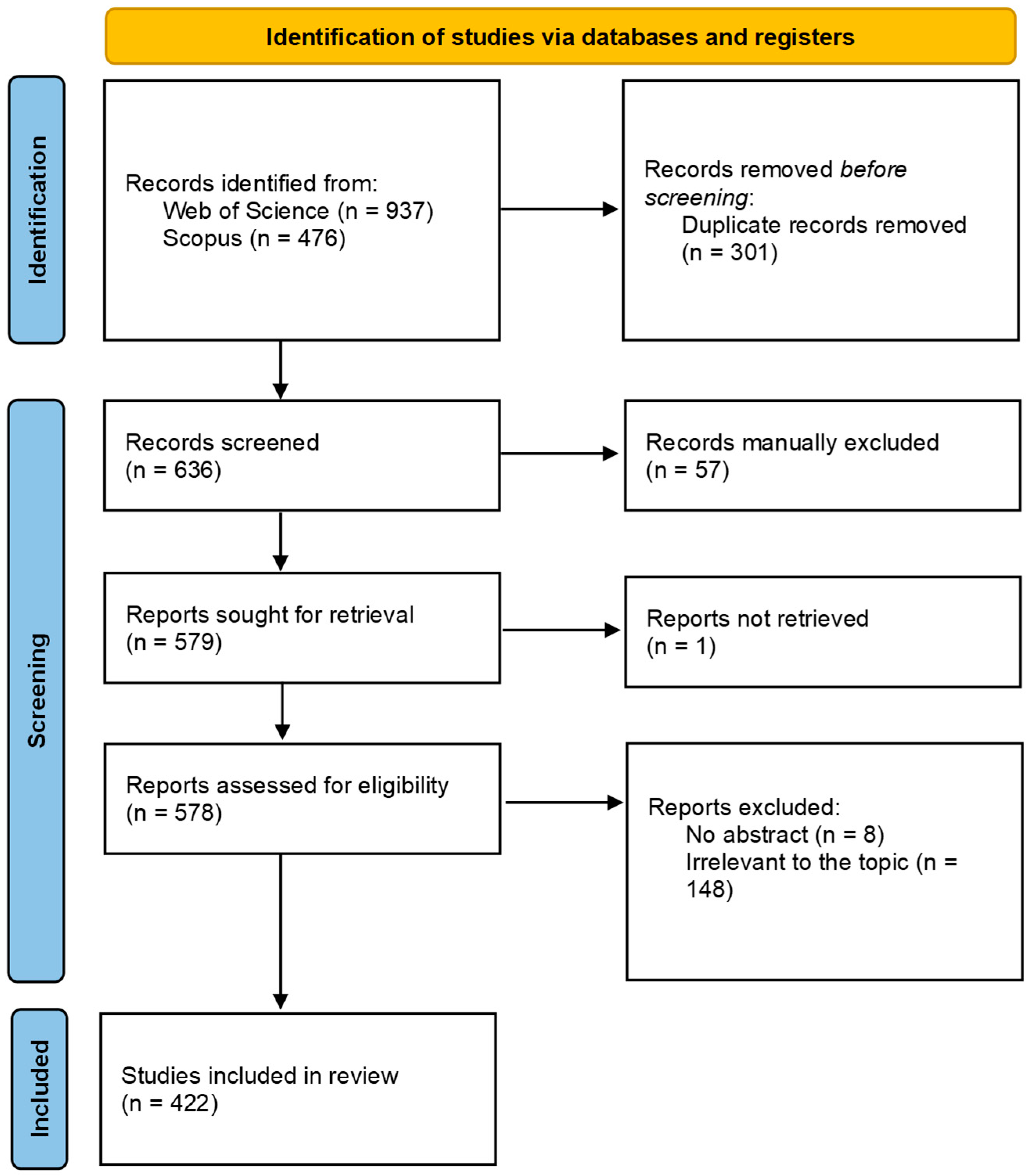
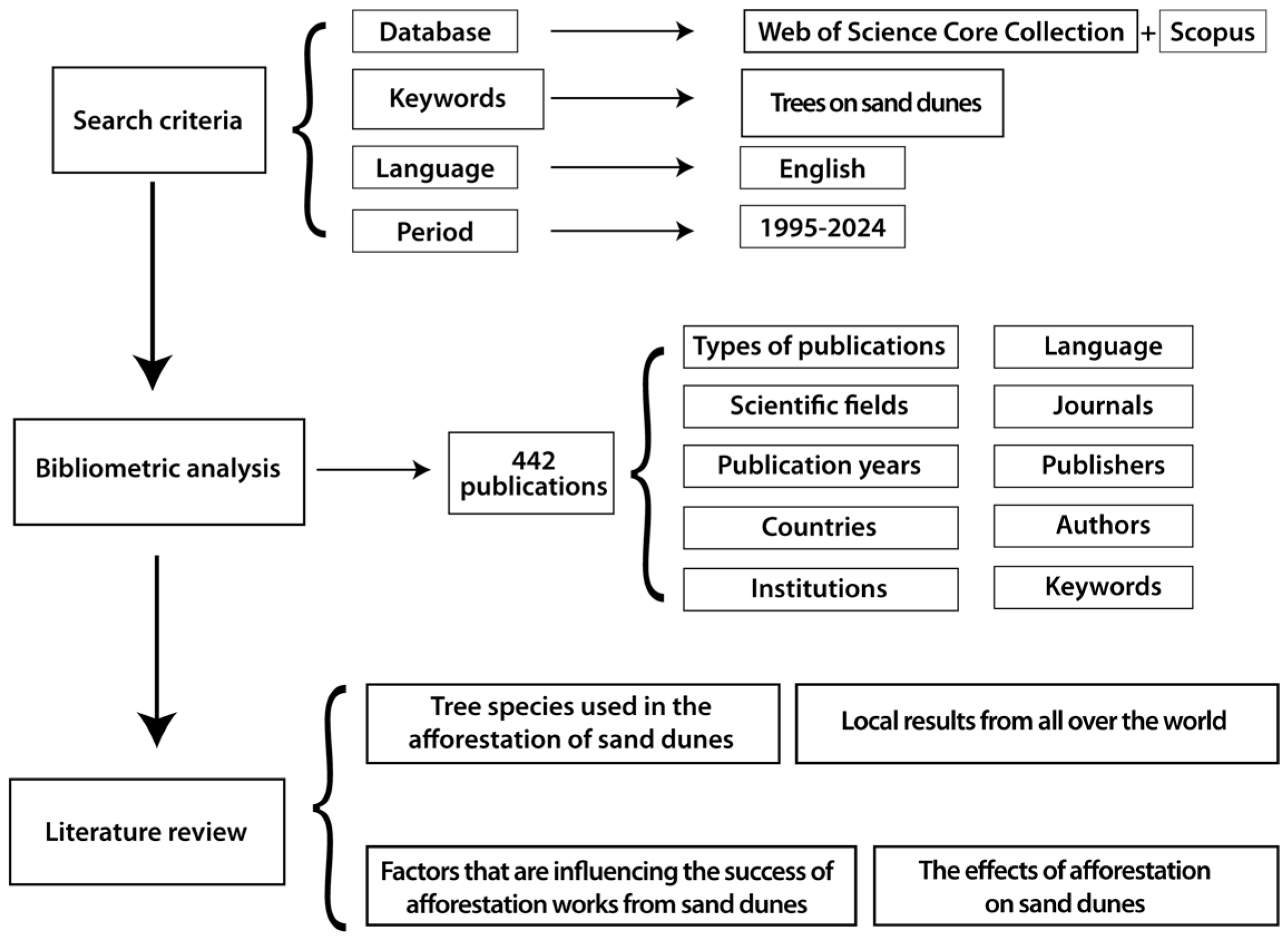
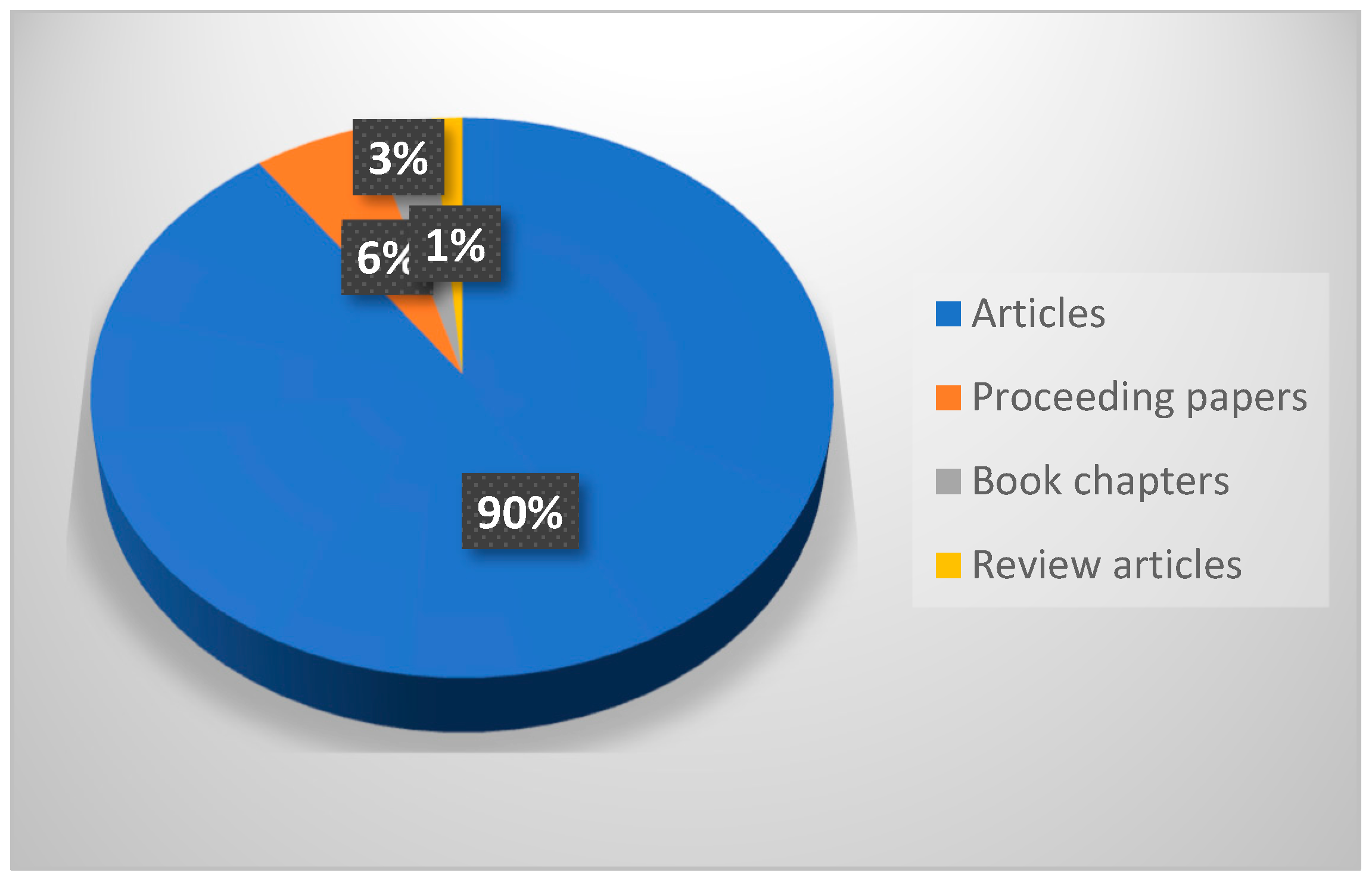

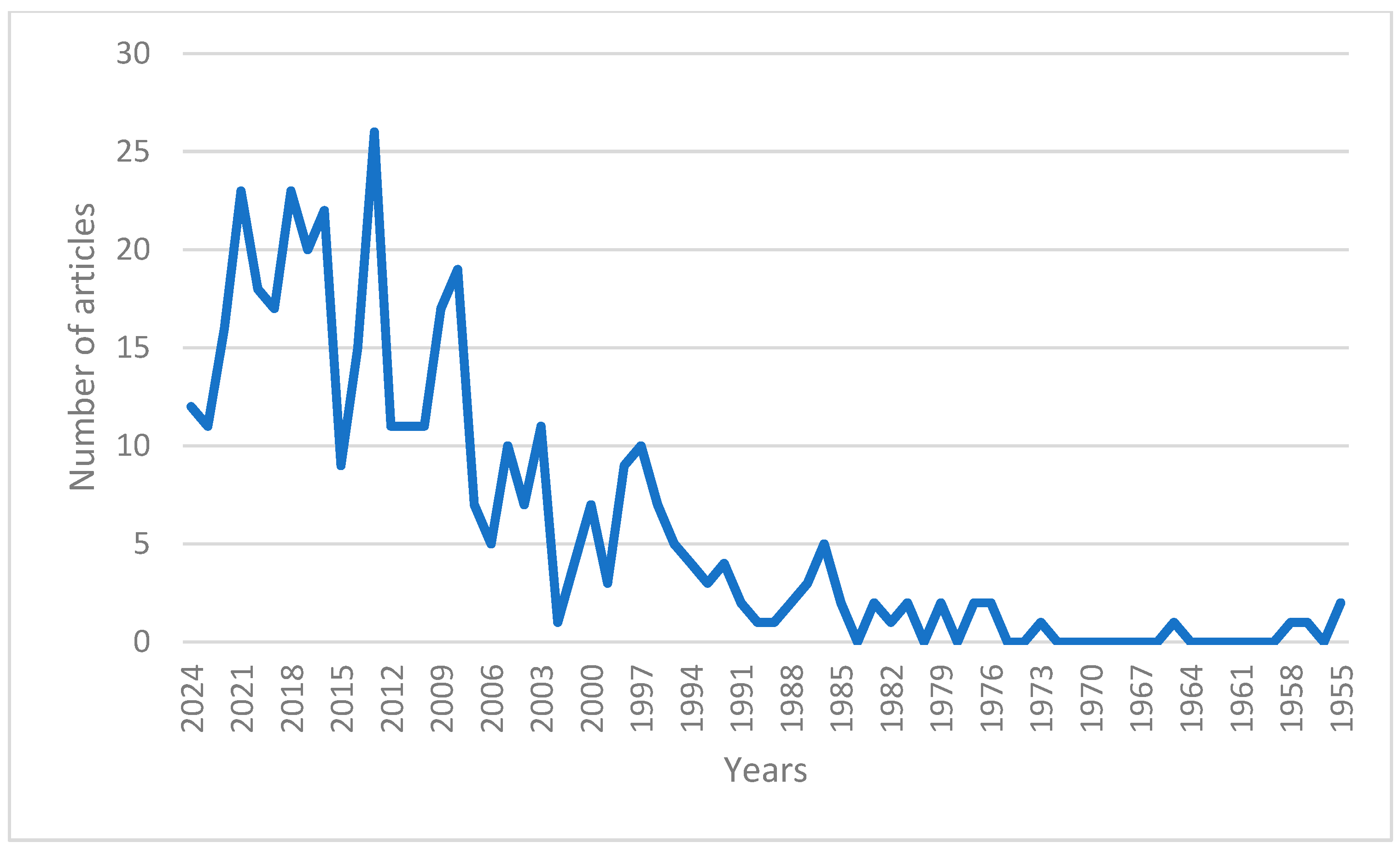
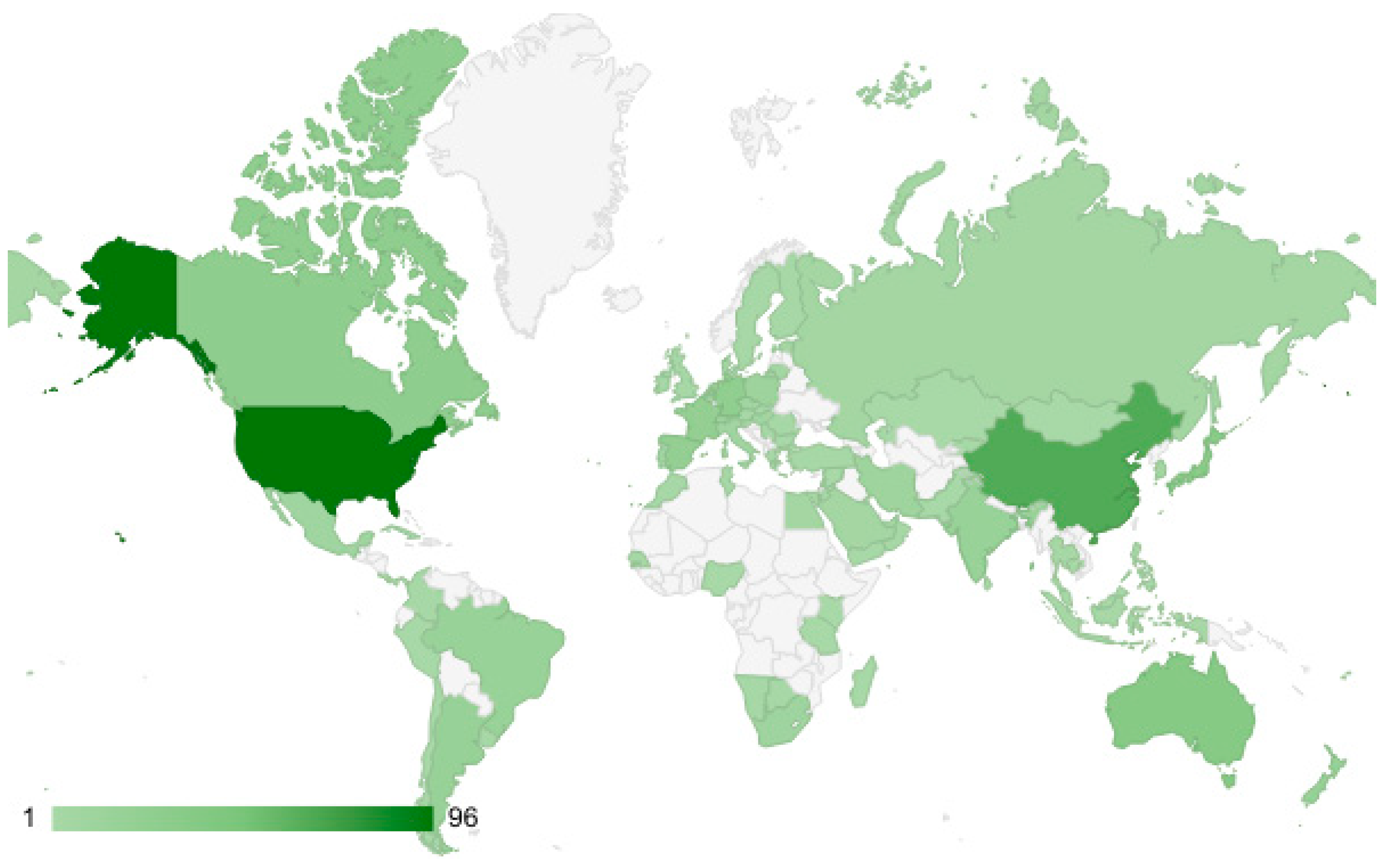
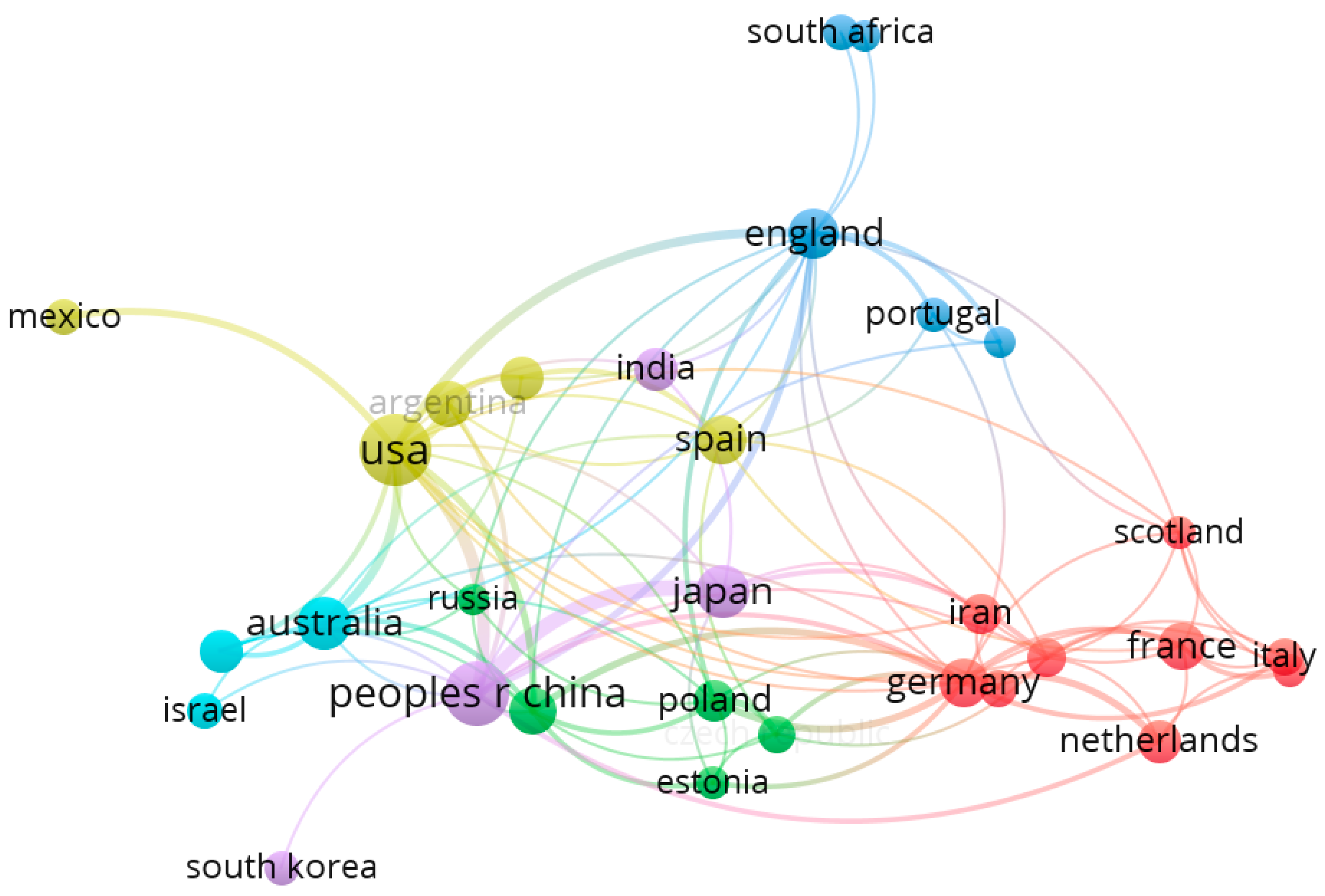
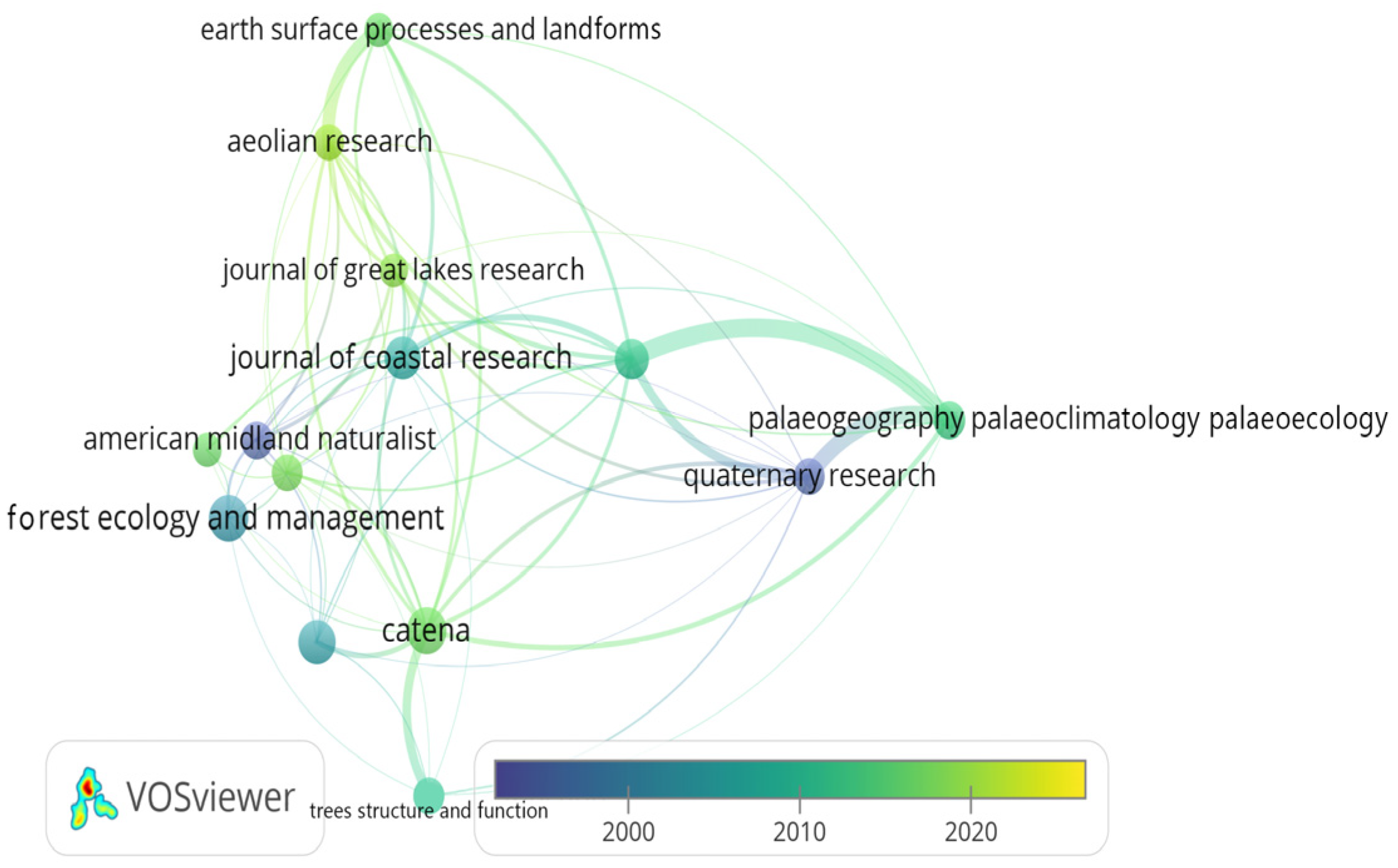
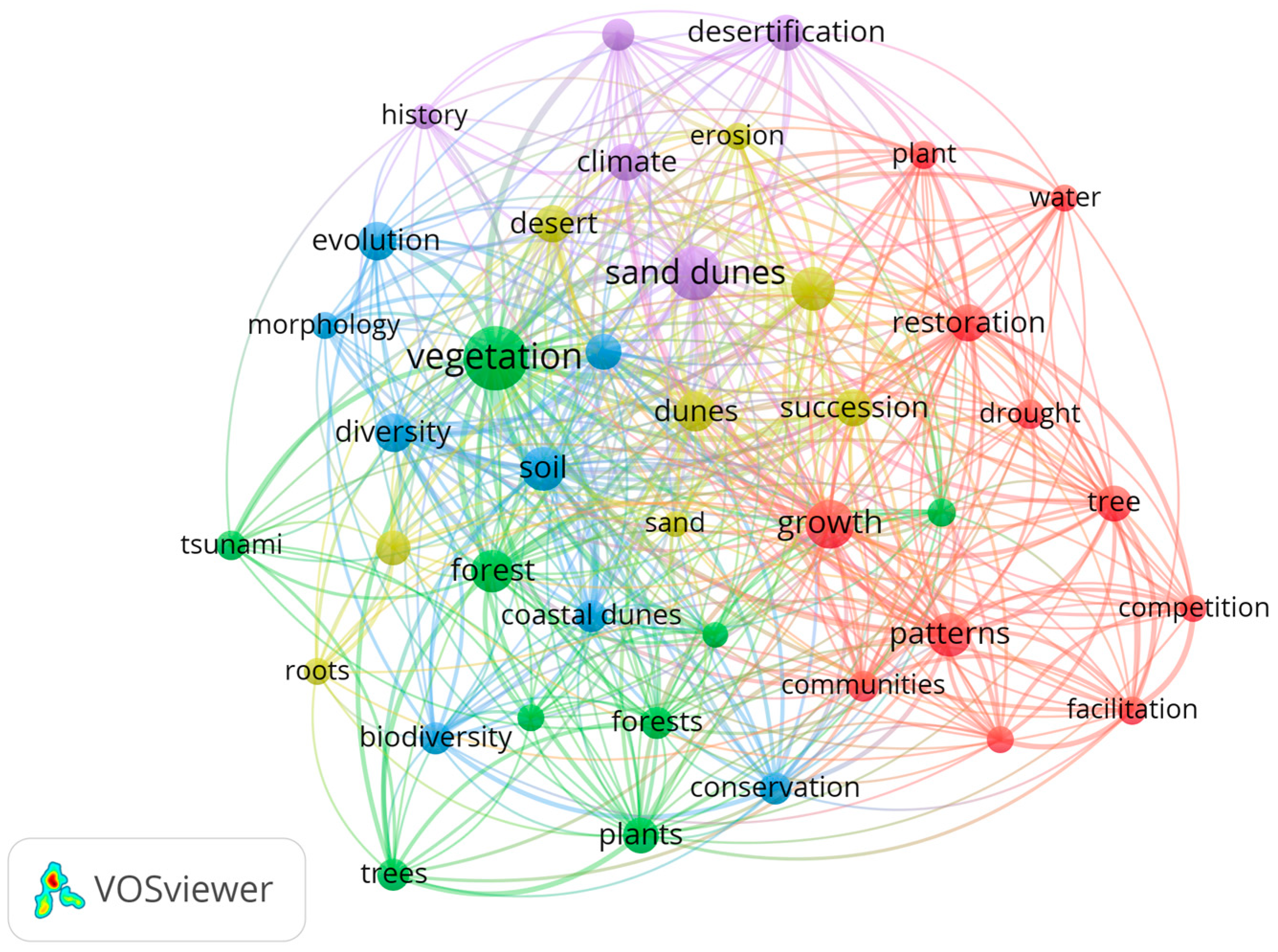

| Crt. No. | Journal | Documents | Citations | Total Link Strength |
|---|---|---|---|---|
| 1 | Catena | 14 | 264 | 12 |
| 2 | Forest Ecology and Management | 14 | 461 | 4 |
| 3 | Journal of Arid Environments | 12 | 210 | 3 |
| 4 | Journal of Coastal Research | 11 | 126 | 4 |
| 5 | Geomorphology | 9 | 215 | 9 |
| 6 | Quaternary Research | 6 | 447 | 11 |
| 7 | Tree-structure and Function | 6 | 125 | 8 |
| 8 | Aeolian Research | 6 | 41 | 5 |
| 9 | Journal of Coastal Conservation | 6 | 60 | 2 |
| 10 | Earth Surface Processes and Landforms | 5 | 166 | 6 |
| 11 | Restoration Ecology | 4 | 79 | 4 |
| 12 | Sustainability | 4 | 25 | 4 |
| 13 | Journal of Arid Land | 4 | 85 | 3 |
| 14 | Annals of Arid Zones | 4 | 36 | 1 |
| Crt. No. | Keyword | Occurrences | Total Link Strength |
|---|---|---|---|
| 1 | vegetation | 65 | 173 |
| 2 | sand dunes | 45 | 99 |
| 3 | soil | 30 | 94 |
| 4 | growth | 38 | 79 |
| 5 | restoration | 22 | 68 |
| 6 | dynamics | 30 | 66 |
| 7 | patterns | 31 | 66 |
| 8 | succession | 22 | 61 |
| 9 | forest | 28 | 60 |
| 10 | diversity | 24 | 59 |
| 11 | plants | 21 | 54 |
| 12 | desert | 22 | 53 |
| 13 | dunes | 26 | 52 |
| 14 | tree | 20 | 51 |
| 15 | climate | 22 | 42 |
| 16 | desertification | 21 | 40 |
| Crt. No. | Tree Species | Region | Risk Level/Invasiveness on Sand Dunes | Citing Article |
|---|---|---|---|---|
| 1 | Abies sachalinensis F.Schmidt | Japan | Low–Native, non-invasive | Nishijima et al., 2004 [46] |
| 2 | Acacia auriculiformis A.Cunn. ex. Benth. | Malaysia | Medium–Fast-growing, naturalized; potentially invasive | Ang et al., 2006 [47] |
| 3 | Acacia cyanophylla Lindl. | Marocco | High–Invasive in Mediterranean regions | Dounas et al., 2022 [48] |
| 4 | Acacia mangium Willd. | Malaysia | Medium–Known for invasiveness in some tropical zones | Ang et al., 2006 [47] |
| 5 | Acacia nilotica (L.) Willd. | Niger | Low–Native in Africa | Laminou Manzo [49] |
| 6 | Acacia raddiana (Forssk.) Galasso & Banfi | Niger | Low–Native, adapted to arid zones | Laminou Manzo [49] |
| 7 | Acacia saligna (Labill.) H.L.Wendl. | Israel | High–Known invasive in Mediterranean dune ecosystems | Applebaum et al., 2023; Cohen and Bar, 2017 [50,51] |
| 8 | Anacardium occidentale L. | Brazil | Medium–Generally low risk, but can alter ecosystems | Rebelo et al., 2024 [52] |
| 9 | Angophora costata (Gaertn.) Britten | Australia | Low–Native to Australian coasts | Burrows, 1986 [53] |
| 10 | Azadirachta indica A.Juss. | Kenya | Medium–Cultivated; potential invasiveness in drylands | Olukoye et al., 2009 [54] |
| 11 | Bauhinia rufescens Lam. | Niger | Low–Native to Sahel | Laminou Manzo [48] |
| 12 | Caragana microphylla Lam. | China | Low–Native, used for dune stabilization | Li et al., 2025 [55] |
| 13 | Cassia siamea (Lam.) Irwin et Barneby | Vietnam | Medium–Non-native in some zones; potential invader | Harwood et al., 1998 [56] |
| 14 | Casuarina equisetifolia L. | China; Senegal | High–Invasive on tropical/coastal dunes worldwide | Chen et al., 2018; Gao et al., 2019; Ndiaye et al., 1993 [57,58,59] |
| 15 | Cistus creticus L. | Greece | Low–Native Mediterranean species | Daskalopoulos et al., 2021 [60] |
| 16 | Coccoloba uvifera L. | Cuba | Low–Coastal native species | Galardis et al., 2024 [61] |
| 17 | Diphysa americana (Mill.) M.Sousa | Mexico | Low–Native in range | Ramírez-Pinero et al., 2019 [62] |
| 18 | Eucaliptus sp. | China | High–Many species known invaders; site-specific risks | Gao et al., 2019 [58] |
| 19 | Ficus carica L. | Egipt | Medium–Cultivated; may become naturalized | Abdel-Rahman, 2010 [63] |
| 20 | Haloxylon aphyllum Minkw. | Kazakhstan | Low–Native in arid zones | Chlachula and Zhagloskaya, 2017 [64] |
| 21 | Haloxylon salicornicum (Moq.) Bunge ex Boiss. | India | Low–Native and adapted | Saxena and Singh, 1976 [65] |
| 22 | Juniperus communis L. | Serbia | Low–Native European species | Cuk et al., 2023 [66] |
| 23 | Juniperus oxycedrus L. | Spain | Low–Native, non-invasive | Rubio-Casal et al., 2010 [67] |
| 24 | Juniperus phoenicea L. | Spain | Low–Native, dune stabilizer | Armas and Pugnaire, 2009; Rubio-Casal et al., 2010 [67,68] |
| 25 | Juniperus virginiana L. | Serbia | Medium–Can spread aggressively in some climates | Cuk et al., 2023 [66] |
| 26 | Kunzea ericoides (A.Rich.) Joy Thomps. | New Zealand | Low–Native and effective | Smale, 1994 [69] |
| 27 | Leptospermum laevigatum (J. Garete.) F. Muell. | South Africa | High–Aggressive invasive in some areas | Gordon, 1999 [70] |
| 28 | Litsea glutinosa | China | Low–Native, used for restoration | Gao et al., 2018 [71] |
| 29 | Pandanus odorifer (Forssk.) Kuntze | Thailand | Low–Coastal native | Marod et al., 2020 [72] |
| 30 | Picea glauca [Moench] Voss | Canada | Low–Native, boreal zones | Cournoyer and Filion, 1994 [73] |
| 31 | Picea glehnii F.Schmidt | Japan | Low–Native to Japan | |
| 32 | Pinus halepensis Mill. | Tunisia; Greece | Medium–Naturalized, may displace native shrubs | Bouachir et al., 2017; Daskalopoulos et al., 2021 [60,74] |
| 33 | Pinus nigra J.F.Arnold | Belgium; USA | Medium–Naturalized, long-term impacts debated | Ampe and Langohr, 2003; Gulezian and Nyberg, 2011 [75,76] |
| 34 | Pinus pinea L. | Tunisia | Low–Widely planted Mediterranean native | Bouachir et al., 2017 [74] |
| 35 | Pinus radiata D.Don | Argentina; UK; New Zealand | High–Documented invasive in New Zealand and South Africa | Amiotti et al., 2013; Beets et al., 2001; Hill and Wallace, 1989 [77,78,79] |
| 36 | Pinus resinosa (Sol. Ex Aiton) | Canada | Low–Native boreal pine | Kellman and Kading, 1992 [80] |
| 37 | Pinus sylvestris L. | Serbia | Low–Native across Europe | Cuk et al., 2023 [66] |
| 38 | Pinus strobus L. | Canada | Medium–Some invasiveness reported outside native range | Kellman and Kading, 1992 [80] |
| 39 | Pinus taeda L. | Brazil | High–Invasive in South America and Africa | Fischer et al., 2014 [81] |
| 40 | Pinus thunbergii Parl. | Japan | Low–Coastal stabilizer in Japan | Nanko et al., 2019 [82] |
| 41 | Populus alba var. pyramidalis L. | China | Medium–Clonal spread; invasive tendencies in some zones | Otoda et al., 2013 [83] |
| 42 | Prosopis chilensis Stunz. | Niger | Medium–Controversial; invasive outside native range | Laminou Manzo [49] |
| 43 | Prosopis cineraria (L.) Druce | India | Low–Native, culturally important | Saxena and Singh, 1976 [65] |
| 44 | Prosopis juliflora (Sw.) Raf. | Iran | High–Highly invasive in many arid regions | Moradi et al., 2017 [84] |
| 45 | Prunus serotina (Ehrh.) | Hungary | High–Major invader in Europe | Juhasz and Bagi, 2009 [85] |
| 46 | Quercus robur L. | France | Low–Native oak species | Ampe and Langohr, 2003; Muhamed et al., 2013 [76,86] |
| 47 | Quercus rubra L. | Canada | Medium–Invasive in some European countries | Kellman and Kading, 1992 [80] |
| 48 | Robinia pseudoacacia L. | Serbia; Romania | High–Widely invasive in Europe | Cuk et al., 2023; Ciuvat et al., 2023 [65,87] |
| 49 | Salix alaxensis (Andersson) Coville | Canada | Low–Native riparian species | Purdy and Bayer, 1995 [88] |
| 50 | Salix silicicola L. | Canada | Low–Native willow species | Purdy and Bayer, 1995 [88] |
| 51 | Syzygium antisepticum (Blume) Merr. & L.M.Perry | Thailand | Low–Native, low ecological risk | Marod et al., 2020 [73] |
| 52 | Syzygium grande (Wight) Walp. | Thailand | Low–Native, low ecological risk | Marod et al., 2020 [73] |
| 53 | Tamarix sp. | Israel | High–Invasive in arid regions | Lipp, 1995 [89] |
| 54 | Tamarix aphlylla (L.) H.Karst. | Iran; Israel | High–Saline soil spreader; documented invader | Nouri Sadegh et al., 2012; Arbel et al., 2005 [90,91] |
| 55 | Ulmus pumila L. | Mongolia | High–Known invader in North America and Europe | Jiang et al., 2014 [92] |
Disclaimer/Publisher’s Note: The statements, opinions and data contained in all publications are solely those of the individual author(s) and contributor(s) and not of MDPI and/or the editor(s). MDPI and/or the editor(s) disclaim responsibility for any injury to people or property resulting from any ideas, methods, instructions or products referred to in the content. |
© 2025 by the authors. Licensee MDPI, Basel, Switzerland. This article is an open access article distributed under the terms and conditions of the Creative Commons Attribution (CC BY) license (https://creativecommons.org/licenses/by/4.0/).
Share and Cite
Dinca, L.; Coca, A.; Tudose, N.C.; Marin, M.; Murariu, G.; Munteanu, D. The Role of Trees in Sand Dune Rehabilitation: Insights from Global Experiences. Appl. Sci. 2025, 15, 7358. https://doi.org/10.3390/app15137358
Dinca L, Coca A, Tudose NC, Marin M, Murariu G, Munteanu D. The Role of Trees in Sand Dune Rehabilitation: Insights from Global Experiences. Applied Sciences. 2025; 15(13):7358. https://doi.org/10.3390/app15137358
Chicago/Turabian StyleDinca, Lucian, Aurora Coca, Nicu Constantin Tudose, Mirabela Marin, Gabriel Murariu, and Dan Munteanu. 2025. "The Role of Trees in Sand Dune Rehabilitation: Insights from Global Experiences" Applied Sciences 15, no. 13: 7358. https://doi.org/10.3390/app15137358
APA StyleDinca, L., Coca, A., Tudose, N. C., Marin, M., Murariu, G., & Munteanu, D. (2025). The Role of Trees in Sand Dune Rehabilitation: Insights from Global Experiences. Applied Sciences, 15(13), 7358. https://doi.org/10.3390/app15137358







